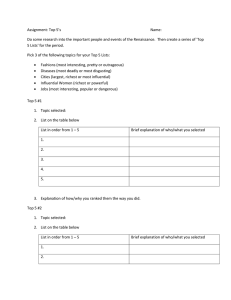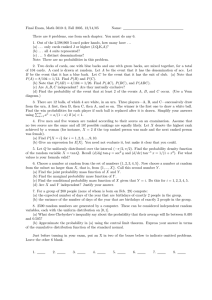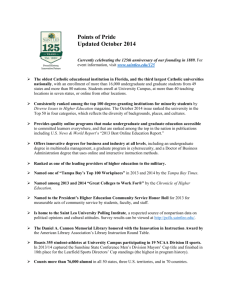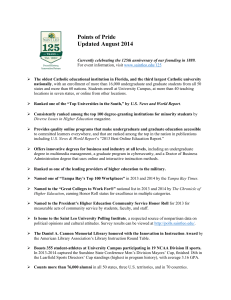Research Journal of Applied Sciences, Engineering and Technology 5(12): 3262-3272,... ISSN: 2040-7459; e-ISSN: 2040-7467
advertisement
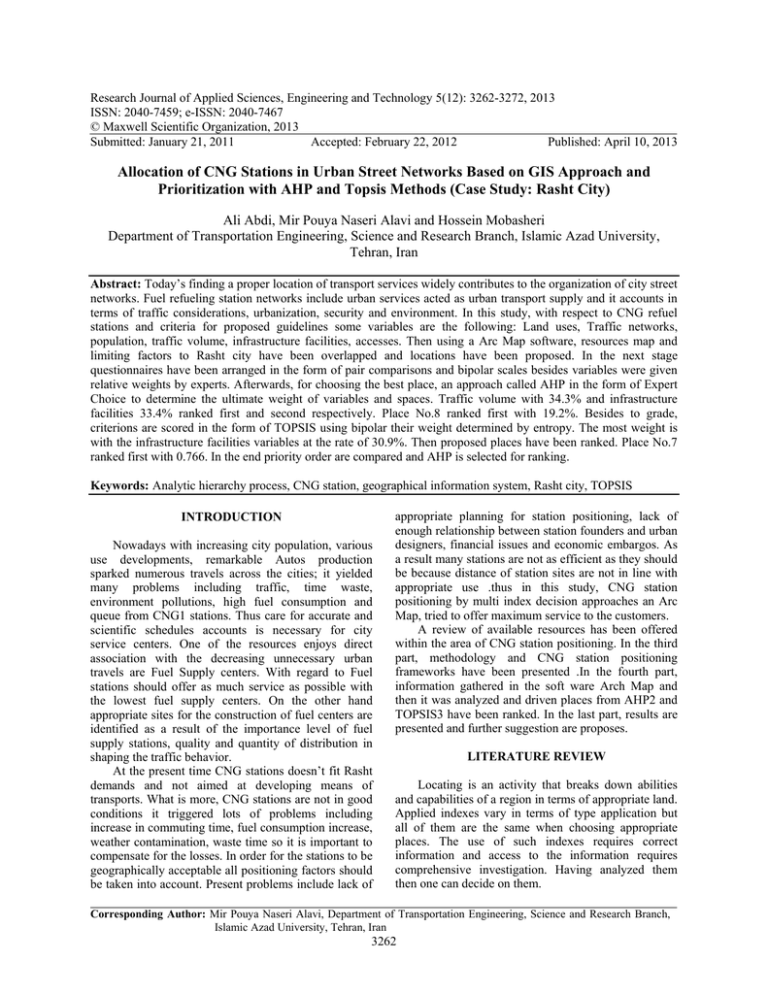
Research Journal of Applied Sciences, Engineering and Technology 5(12): 3262-3272, 2013
ISSN: 2040-7459; e-ISSN: 2040-7467
© Maxwell Scientific Organization, 2013
Submitted: January 21, 2011
Accepted: February 22, 2012
Published: April 10, 2013
Allocation of CNG Stations in Urban Street Networks Based on GIS Approach and
Prioritization with AHP and Topsis Methods (Case Study: Rasht City)
Ali Abdi, Mir Pouya Naseri Alavi and Hossein Mobasheri
Department of Transportation Engineering, Science and Research Branch, Islamic Azad University,
Tehran, Iran
Abstract: Today’s finding a proper location of transport services widely contributes to the organization of city street
networks. Fuel refueling station networks include urban services acted as urban transport supply and it accounts in
terms of traffic considerations, urbanization, security and environment. In this study, with respect to CNG refuel
stations and criteria for proposed guidelines some variables are the following: Land uses, Traffic networks,
population, traffic volume, infrastructure facilities, accesses. Then using a Arc Map software, resources map and
limiting factors to Rasht city have been overlapped and locations have been proposed. In the next stage
questionnaires have been arranged in the form of pair comparisons and bipolar scales besides variables were given
relative weights by experts. Afterwards, for choosing the best place, an approach called AHP in the form of Expert
Choice to determine the ultimate weight of variables and spaces. Traffic volume with 34.3% and infrastructure
facilities 33.4% ranked first and second respectively. Place No.8 ranked first with 19.2%. Besides to grade,
criterions are scored in the form of TOPSIS using bipolar their weight determined by entropy. The most weight is
with the infrastructure facilities variables at the rate of 30.9%. Then proposed places have been ranked. Place No.7
ranked first with 0.766. In the end priority order are compared and AHP is selected for ranking.
Keywords: Analytic hierarchy process, CNG station, geographical information system, Rasht city, TOPSIS
INTRODUCTION
Nowadays with increasing city population, various
use developments, remarkable Autos production
sparked numerous travels across the cities; it yielded
many problems including traffic, time waste,
environment pollutions, high fuel consumption and
queue from CNG1 stations. Thus care for accurate and
scientific schedules accounts is necessary for city
service centers. One of the resources enjoys direct
association with the decreasing unnecessary urban
travels are Fuel Supply centers. With regard to Fuel
stations should offer as much service as possible with
the lowest fuel supply centers. On the other hand
appropriate sites for the construction of fuel centers are
identified as a result of the importance level of fuel
supply stations, quality and quantity of distribution in
shaping the traffic behavior.
At the present time CNG stations doesn’t fit Rasht
demands and not aimed at developing means of
transports. What is more, CNG stations are not in good
conditions it triggered lots of problems including
increase in commuting time, fuel consumption increase,
weather contamination, waste time so it is important to
compensate for the losses. In order for the stations to be
geographically acceptable all positioning factors should
be taken into account. Present problems include lack of
appropriate planning for station positioning, lack of
enough relationship between station founders and urban
designers, financial issues and economic embargos. As
a result many stations are not as efficient as they should
be because distance of station sites are not in line with
appropriate use .thus in this study, CNG station
positioning by multi index decision approaches an Arc
Map, tried to offer maximum service to the customers.
A review of available resources has been offered
within the area of CNG station positioning. In the third
part, methodology and CNG station positioning
frameworks have been presented .In the fourth part,
information gathered in the soft ware Arch Map and
then it was analyzed and driven places from AHP2 and
TOPSIS3 have been ranked. In the last part, results are
presented and further suggestion are proposes.
LITERATURE REVIEW
Locating is an activity that breaks down abilities
and capabilities of a region in terms of appropriate land.
Applied indexes vary in terms of type application but
all of them are the same when choosing appropriate
places. The use of such indexes requires correct
information and access to the information requires
comprehensive investigation. Having analyzed them
then one can decide on them.
Corresponding Author: Mir Pouya Naseri Alavi, Department of Transportation Engineering, Science and Research Branch,
Islamic Azad University, Tehran, Iran
3262
Res. J. Appl. Sci. Eng. Technol., 5(12): 3262-3272, 2013
One of the most important studies conducted
within the area of area of fuel supply stations. A study
conducted by Melendez and Milbrandt (2008) in
collaboration with Renewable Energy Organizations
and America Energy Department in 2008 entitled
Regional demand and Hydrogen Stations Optimization.
The goal of this study was to identify barriers to station
developments, identification and qualifying resolutions
potentials to overcome them. In this study Geographical
information system software and excel have been used.
Data are divided into two parts maps and tables for each
Geographical element. Geographical information mix
and table forms, used to analyze different Geographical
spaces (Melendez and Milbrandt, 2008).
Christopher up church and Michael kuby applied
fuel optimization in two popular ways p-median and
flow-refueling. P Model is widely used it decreases the
total weight of traveled distance with devoting nodes
Where as the second model is based on the demand
routes that chooses places to increase the number of
travels in this study locating is carried out using
positioning in the shortest route. The places are better
than refueling commuting that is through p-median
model. The difference of these two methods in the state
scale is more than city scale (Upchurch and Kuby,
2010).
The study of hydrogen station optimization in
Florida conducted by Kuby et al. (2009) using FlowRefueling location model. This model applied to
locating in the form of maximum volume of
transportation. The inputs of the models includes:
average speed, destination and starting line of
commuting volume .Geographical information System
and creative algorithm in the backup system of decision
become uniform. This model have been used in Florida
for primary distribution of stations in urban and state
application. The results show that the increasing
cooperation between the stations and their good
performance help the data to become categorized (Kuby
et al., 2009).
The study conducted by Dambatta et al. (2009)
tilted hierarchical analysis process to manage polluted
lands in 2009. The approach taken care of decision
analysis, backup techniques from decision makers on
management of complex issues, lack of certainties.
Several methods have been used to decide on
environment issues this study took care of different
methods. To decide and analyzes Environment
management issues. The study underscores hierarchical
analysis process a growing analysis -decision
techniques have been used at different levels of
planning and environment and rising resources
(Dambatta et al., 2009).
Adsavakulchai and Huntula (2010) conducted fuel
positioning supply stations using GIS1 in Bangkok
Current integration in GIS ranked first compared to
other positioning approaches. The variables in this
method directly evaluates the cost and efficiency of fuel
supply stations. Some of the variables close to
population centers distance between two centers auto
jam, land prices, the number of gas fuels motorists.
Study result overlaid from layers accumulation in the
software Arc View. Each region potential determined
for CNG stations and appropriate sites represented for
station construction (Adsavakulchai and Huntula,
2010).
In the study entitled methods representations of
appropriate positioning for CNG station in a city target
function is defined as the total expenditure it also taken
quality and quantity factors into account. Evaluation of
these factors is made of AHP in the sense that important
indices have been chosen from among common indices
of CNG stations. They are ranked, weighted by experts
they go through judgment and decision based on AHP
method. They are tested by software called expert
choice so the total weight can be calculated. Then PSO
algorithm is used as a Meta heuristic algorithm. To
solve problems encoded in the MATLAB setting. Then
a case sample of is introduced for assessment.
METHODOLOGY
In this study, first all surveys are taken into
account, effective factors on CNG station positioning
are defined. The descriptive and spatial data are
gathered. Then data are inserted into Arc Map software
and analyzed. First required layers are built based on
their structure, linear, point, polygon in Arc Catalog. It
is added to Arc Map. Map drawing tools are used to
provide appropriate and inappropriate layers of the
CNG stations in order to draw areas to buffer function
is used. All plans for overlaying appropriate places are
used to construct a CNG stations. Hierarchical and
entropy are used to determine the significance of
places. Related elements are compared at the higher
level in a pair. Their weights are calculated. Then total
weights of each weight are calculated based on relative
weights called ultimate weight. Parameters are ranked
based on their bipolar scales in entropy method. So
ultimate weight is reached in the form of TOPSIS it is
time to calculate ranking the proposed sites. A survey
conducted from experts, municipality, Oil Corporation,
Gas Company, deputy urbanization, deputy transport,
overall 25 questionnaire have been distributed and
analyzed.
EFFECTIVE FACTORS ON CNG STATIONS
POSITIONING
As CNG station locating is based on the effective
factors leading to higher efficiency thus determining
such factor play an important role in locating and
ranking CNG stations.
3263
Res. J. Appl. Sci. Eng. Technol., 5(12): 3262-3272, 2013
1-Compatible 1-Green area
1. Land use
2-Arid area
2-Incompatible
1- Residential uses
2- Commerce uses
3- Administrative uses
4- Education uses
5- Remedial uses
2. Street networks
1- Distance to intersection
2- Lack of settlement in sheer curve
3. Access
Effective factors
on CNG stations
Positioning
1- First rate arterial
2- Main second rate arterial
3- Accessory second rate arterial
4- Local
1- High
4. Traffic volume
2- fairly high
3- Average
4- Fairly low
5- Low
5. Population 1- High Congestion
2- Average Congestion
3- Low Congestion
1- Proximity to gas pip
6. Infrastructure facilities
2- Proximity to electricity net
Fig. 1: Factors parameters on position and CNG station ranking
Major effective factors of CNG station positioning.
traffic volume, access, population, land use, street
networks, facilities can cause efficiency. Above
mentioned factors are going to be categorized in the
sense that factors which are at the same level, are not
under one category nor comparable. Therefore, the
definition of each effective factor is defined categorized
in Fig. 1.
Land uses: One of the factors that lead to appropriate
service is the manner of placement, it's locating and
neighboring uses divided into compatible and
incompatible. We describe each below.
Compatible application: One of the factors that lead to
a proper service is neighboring uses divided into two
types compatible and incompatible including: green
area, parks, arid area.
Incompatible application: Application whose
proximity does harm. So they have adverse impact on
citizen, mental and health condition. The applications
of the CNG are residential, remedial and administrative
centers.
Traffic volume: One of the effective factors of CNG
station locating is the streets traffic volume leading to
increasing sale of CNG stations fuels thus it encourages
private sectors investors. In this study, traffic volume
parameter, divided into five parts, high, fairly high,
average, fairly low and low.
Facilities: One of the major factors in CNG station
locating deals with access to gas pipes and electricity
nets. One of the primary needs of a CNG station is
concerned with electricity supply of the station.
Since all facilities use to start up the station are run
by electricity, besides gas transit and composite should
3264
Res. J. Appl. Sci. Eng. Technol., 5(12): 3262-3272, 2013
be accessible because the first point of founding a CNG
station is proximity to 250 psi gas pipe.
Street networks: One of the most vital urban
applications is street networks. All application requires
access net based on their performances. The
unsettlement of CNG station on the sheer curves and
intersections are under access network factors.
Fire station
Populations: Population congestion seemed to be the
most inappropriate factor in the allocation of sites and
founding different uses urban service supply.
Population helps use facilities far better it is divided
into three parts high congestion, average and low.
Access: One of the main variables of station locating is
the manner of access to the station from expert
perspectives. It is vivid that the movements of vehicles
vary based on the road performances. Vehicle is driven
faster on express roads than they are in the intercity
roads. Thus they should be founded near main streets of
the cities. As cars are widely used near main streets the
need for CNG foundation are strongly felt. So that
Station can offer further services. This is divided into
four. First rate arterial, main second rate arterial,
accessory second rate arterial and local.
Fig. 2: Compatible places plans for founding CNG stations
LOCATING
When major variables are identified and
information is gathered it is time for the geographical
information base to be founded. Then appropriate layers
are developed in Arc Map then outputs are produced.
They are so called factor maps added to CNG Stations
locating as followed and took advantage of Arc Map.
First layers compatible with stations including
compatible uses facilities, population and traffic
volumes are added to the software in the form of
polygon and linear. Then all compatible layers are
selected. Then they are overlaid using a union function.
A new layer composed of all compatible layers of CNG
stations. Incompatible layers with the station and illegal
buffer such as distance to remedial, educational centers
are added to the software. Then they are overlaid with
union command. A new layer including incompatible
and buffer. Then using an intersect function similar
sites between two compatible and incompatible layers
with station use is achieved. After wards similar points
are eliminated from layers compatible with station use.
Compatible places for founding stations are determined
as shown in Fig. 2. There are a few samples of
compatible layers plans and stations area are shown in
Fig. 3 to 8.
Fire station
Fig. 3: Plans for compatible land uses with stations
software are used. Using software called traffic volume
access, network, land use, population and facilities. The
results show that there are 7% inconsistencies when it is
10% lower than the standard one. It is an indicative of
accurate questionnaire design.
The extent of effective factors and parameters:
Questionnaire results show that the extant of
importance are as follow:
In this section, effective parameters on each factor
The first traffic volume factor amounts to 34.3%
and proposed places are ranked. It goes without saying
are the most important one. Then the facilities amount
that to facilitate operation; AHP and Expert choice
to 33.4% ranked second. Access amounts to 15.3%
3265
THE DEGREE OF SIGNIFICANCE FACTORS
ON AHP RANKING
Res. J. Appl. Sci. Eng. Technol., 5(12): 3262-3272, 2013
Fig. 4:
The degree of significance of effective factors on station ranking
Fig. 7: Plans for compatible distance from gas pipes
Fig. 5: For privacy residential area
Fig. 8: Remedial uses area
Fig. 6: Plans for access ranking plans
ranked third. Street networks ranked last with 3.3%.
Thus traffic volumes and facilities play a very big role
when stations are ranked. Lack of these two factors is
unjustifiable. The degree of significance is shown in
Fig. 4.
3266
Res. J. Appl. Sci. Eng. Technol., 5(12): 3262-3272, 2013
Fig. 9: Significance of traffic network parameters
Fig. 10: Significance of land use parameter
Fig. 11: The significance of land use
Fig. 12: The significance of incompatible use parameter
Fig. 13: The significance of population
The degree of street network significance: The
significance is shown in Fig. 9. As shown unsettlement
parameters amount to 21.6% called curve, unsettlement
parameter amount to 78, 4% on the intersection.
Significance of land use parameter: The significance
is shown in Fig. 10. As shown, Compatible parameters
amount to 13.7% and incompatible use parameters
amounts to 13.7%.
amounts to 27% ranked second. Educational use
amounts to 25.2% ranked third Commercial use
amounts to 8.1% ranked fourth, administrative use
amounts to 7.1% ranked fifth. Thus keeping station
distance from residential, remedial, educational uses
play a role in station ranking.
Significance of compatible use parameter: Figure 11
indicates the significance of the parameter, green area,
parks amount to 61.4%. And arid area amounts to
38.6%.
The significance of population: It is shown in Fig. 13
high signals high congestion amounts to 72.7%.
Medium character- rustic's average congestion amounts
to 19.7% ranked the second, low characteristics low
congestion amount to 7.5% ranked last. Therefore, high
congestion has an impact on places and station ranking.
The significance of compatible use parameter: In
compatible use parameter is shown in Fig. 12.
Residential use amounts to 32.7% then remedial use
The significance of access: Figure 14 shows the
significance of access .As it is shown, arterial 1 amount
to 54.4% represents the most important parameter,
3267
Res. J. Appl. Sci. Eng. Technol., 5(12): 3262-3272, 2013
Fig. 14: The significance of access parameters
Fig. 15: The significance of facilities
Fig. 16: The significance of traffic volume parameters
arterial 2-org amounts to 27% ranked second, Arterial
2-non-org amounts to 13, 5% ranked third and local
amounts to 5.1% ranked the lowest .Thus it is very
important to have access to Arterial and proximity to
main routes.
The significance of facilities: Figure 15 shows the
significance of this parameter. Proximity to gas pipes
250 psi called weight 79% ranked first and proximity to
electricity net weighing 21, 0% ranked second. Thus
proximity to gas pipes is four times as important as
proximity to electricity net regarded as important
station locating and ranking.
Table 1: The significance of parameter and places related to them
Parameter
Places/ Weight
1
Green area and parks
61.4
24.9
Arid area
38.6
22.7
Residential use
32.7
26.2
Commercial use
8.1
26.0
Administrative use
7.1
17.8
Educational use
25.2
23.8
Remedial use
27.0
25.1
Unsettlement on sheer curve
21.6
17.4
Unsettlement on the intersection
78.4
8.2
First rate arterial
54.4
24.4
Main first rate arterial
27.0
24.3
Accessory second rate arterial
13.5
24.0
Local
5.1
11.8
High–traffic volume
46.8
14.3
Rather high–traffic volume
30.7
14.6
Average –traffic volume
12.5
14.3
Rather low-traffic volume
6.2
13.9
Low-traffic
8.3
13.8
High congestion-population
72.7
3.7
Average congestion-population
19.7
3.2
Low congestion-population
7.5
3.3
Gas pipe proximity
79.0
24.3
Proximity to electricity net
21.0
27.3
Traffic volume: The significance is shown in Fig. 16.
Very shows high volume amounts to 46, 8% is the top
important parameter. Then Rather very shows high
volume amounts to 30, 7% ranked second, Normal
shows average amounts to 12, 5% ranked third. Little
shows low volume amounts to 3, 8% ranked last. So
high traffic volumes plays a very big role in ranking
and locating.
The significance of all proposed places presented
in Table 1 in isolation. Presented figures are indicative
of above mentioned places. Significance compared to
ranking parameters.
2
10.0
18.2
15.4
11.9
14.8
10.6
14.6
8.4
14.0
17.2
17.0
17.2
8.4
3.7
3.6
3.1
3.2
3.1
14.6
13.4
13.6
15.2
19.2
3268
3
13.1
14.9
11.8
11.5
11.7
11.6
6.9
16.9
12.1
6.1
8.9
6.2
12.4
9.8
15.5
9.5
12.4
12.0
4.6
4.7
4.9
11.6
14.5
4
9.6
10.4
11.3
8.9
15.1
11.1
13.0
13.9
9.0
5.7
5.2
5.8
13.4
5.7
5.3
5.4
5.8
5.9
5.2
5.3
5.4
5.6
5.3
5
10.2
7.4
11.1
12.9
9.6
15.6
8.6
5.5
16.7
17.6
14.9
17.7
10.5
27.7
25.0
28.2
25.0
24.9
12.6
13.5
13.3
12.1
9.8
6
4.4
8.4
4.5
4.7
4.4
4.1
5.0
7.1
13.9
5.4
5.3
5.7
14.8
23.5
18.6
24.7
23.9
24.0
14.4
13.6
13.4
3.7
3.5
7
20.0
11.6
15.1
18.3
19.8
17.6
22.0
18.4
7.1
5.0
4.8
5.0
9.5
2.8
4.0
2.7
4.0
4.1
10.2
11.0
11.1
12.9
17.1
8
7.7
6.5
4.6
5.8
6.9
5.6
4.7
12.3
19.0
18.6
19.4
18.5
19.3
12.5
12.3
12.1
11.9
12.3
34.6
35.3
35.0
14.6
3.3
Res. J. Appl. Sci. Eng. Technol., 5(12): 3262-3272, 2013
Fig. 17: Weight and the final ranking places
Fig. 18: Diagram for places weight and ranking based on their whole factors
Ultimate ranking of places: When relative weighing
of places in relation to parameters are done and ultimate
weight of each place is conducted. It is mixed at the end
of software with all final weights. As shown in Fig. 17
places No.8 amount to 19.2% ranked first, place No.4
amounts to 17.4% ranked second and place No.1
amounts to 14.7% ranked third. Place No.5 amounts to
6.2% ranked lowest. Graph for places weights are their
ranking based on the whole criteria shown in Fig. 18.
Incompatible)
(Traffic
Volume)
(Access)
(Facilities) (Compatible) (Population) (Traffic network)
X1
7.96
7.32
4.64
4.31
6.65
7.32
5.65
7.65
TOPSIS TYPED RANKING
This method of ranking take advantage of entropy
techniques so that variables are weighed from experts
prospective in the form of bipolar variables. So that
decision matrix of expert poll and their Compilation are
composed of geometric average. For a positive variable
zero expressive minimum value and 10 expressive
value maximum for negative variable zero signifies
value maximum and 10 signifies value minimum. Thus
decision matrix is as following:
X2
8.65
6.32
7.32
6.65
4.64
5.65
7.32
3.63
X3
5.31
7.32
4.31
5.65
6.65
7.32
7.32
7.32
X4
4.93
6.65
1.82
5.65
5.31
7.32
8.32
8.65
X5
8.32
6.65
5.65
7.65
6.32
5.94
7.65
8.32
X6
7.32
3.91
7.96
8.65
5.31
6.65
5.24
7.96
X7
4.31
7.32
4.93
5.31
6.32
6.65
6.95
8.32
in the first step, a matrix lacking scale is as following:
rij
Pij = ∑m
i=1 rij
; ∀ i, j
(1)
In the second step we use P i possibility shown in
Table 2:
3269
E j = K ∑m
i=1[Pij . ln Pij] ∀ j
(2)
Res. J. Appl. Sci. Eng. Technol., 5(12): 3262-3272, 2013
Table 2: Ej possible distribution
x1
Ej
0.99
x2
0.982
x3
0.99
x4
0.997
x5
0.995
x6
0.986
x7
0.99
Table 3: dj deviation degree
x1
dj
0.01
x2
0.018
x3
0.01
x4
0.03
x5
0.005
x6
0.014
x7
0.01
Table 4: Variables weights
x1
Wj
0.103
x2
0.185
x3
0.103
x4
0.309
x5
0.051
x6
0.144
x7
0.103
R
R
R
R
R
0.155 0.172 0.104
0.142 0.126 0.143
� 0.09
0.1
0.08
0.08 0.132 0.110
Pij = �
0.129 0.09 0.130
�0.142 0.112 0.143
0.11 0.146 0.143
0.148 0.07 0.143
R
R
0.101
0.137
0.04
0.116
0.109
0.15
0.17
0.149
0.147
0.118
0.1
0.135
0.112
0.105
0.135
0.147
R
R
0.138
0.074
0.15
0.163
0.1
0.125
0.099
0.15
R
0.086
0.146
0.09 �
0.106
�
0.126
0.133�
0.139
0.166
(3)
We use No.4 relation to calculate available variables
and presented in Table 4:
dj
Wj=∑n
j=1 dj
;∀ j
rij
V=ND.Wn × n
The negative ideal option=S-= {(miniVij�|j ∈ J),
(maxiVij|j ∈ J′)|i = 1, 2, …, m}
(8)
0.412
0.329
0.28
0.379
0.313
0.294
0.379
0.412
0.38
0.203
0.413
0.45
0.276
0.345
0.272
0.414
0.238
0.405
0.273�
0.294
�
0.35
0.368�
0.385
0.46
R
R
R
R
R
d 1 + = 0.067
d 2 + = 0.055
d 3 + = 0.121
d 4 + = 0.062
R
R
R
R
R
R
R
R
R
R
cl 1 + = 0.547
cl 2 + = 0.541
cl 3 + = 0.284
cl 4 + = 0.563
R
R
R
R
R
R
R
R
R
R
R
R
R
R
R
R
0.044
0.04
�0.026
0.024
V= �
0.037
� 0.04
0.03
0.042
0.088
0.064
0.074
0.067
0.047
0.057
0.074
0.037
0.03
0.041
0.024
0.032
0.037
0.041
0.041
0.041
0.084
0.113
0.031
0.096
0.09
0.124
0.14
0.147
R
R
R
R
R
R
R
R
R
R
R
R
R
R
R
R
0.021 0.055 0.024
0.017 0.03 0.042
0.014 0.06 0.028�
0.019 0.065 0.03
�
0.016 0.04 0.036
0.015 0.05 0.038�
0.019 0.039 0.04
0.021 0.06 0.047
0.047، 0.065، 0.021، 0.147، 0.041، 0.088، 0.044 = {S+}
0.024، 0.030، 0.014، 0.031، 0.024، 0.037، 0.024 = {S-}
In the next step separation calculation is made
through relations 9 and 10 and Shown in Table 5 and 6
at negative and positive intervals.
di-= Distance of i negative idea option =
{∑nj=1 (Vij-Vj-)2}0.5; i = 1, 2,…, m
(6)
0.271
0.366
0.1
0.311
0.292
0.403
0.458
0.476
R
R
di+ = Distance of i positive idea option =
(9)
{∑nj=1 (Vij-Vj+)2}0.5; i = 1, 2, …, m
The positive ideal option = S+= {(maxiVij|j ∈
J), ( miniVijj∈J′)i=1, 2, …, m}
(7)
0.428 0.474 0.289
0.394 0.346 0.398
� 0.25 0.401 0.234
0.232 0.364 0.308
ND = �
0.359 0.254 0.362
�0.394 0.31 0.398
0.304 0.401 0.398
0.412 0.199 0.398
R
R
Table 7: Relative proximity of ideal solution
cl 5 + = 0.457
cl 6 + = 0.701
cl 7 + = 0.766
cl 8 + = 0.723
(5)
2
�∑𝑚𝑚
𝑖𝑖=1 rij
R
d 1 - = 0.081
d 2 - = 0.065
d 3 - = 0.048
d 4 - = 0.08
R
nij=
R
R
Table 6: Negative intervals
d 5 - = 0.064
d 6 - = 0.101
d 7 - = 0.118
d 8 - = 0.133
(4)
Most weight related to facilities amount to 0.309
minimum weight is related to 0.051 the lower weight of
w 5 enjoys Ei indicates that the efficacy of variables are
the same. Its significance is negligible when a decision
is made. Then ranking is conducted. In the first step
decision matrix is conducted using relation No.5
becoming a matrix that lacks scale then it uses relation
No.6 to become a non-scale weighted matrix. In the
third step ideal positive and matrix solutions are
calculated based on relations 7 and 8:
R
R
Table 5: Positive intervals
d 5 + = 0.076
d 6 + = 0.043
d 7 + = 0.036
d 8 + = 0.051
In the next step, uncertainty or deviation degree of djis
calculated in Table 3:
dj = 1-Ej;∀ j
R
(10)
In the next step calculation is made ideal solution
of relative Si proximity according to relation 11. Its
results shown in Table 7:
CLi+= (di-)/ (di++di-) , 0 ≤CLi+≤1, i = 1, 2 ,…, m (11)
Places ranking are as the following:
S7> S8> S6> S4> S1> S2> S5> S3
In this method place No.5 amount to 0.766 ranked
first. Later on, place No.8 amounts to 0.723 and place
3270
Res. J. Appl. Sci. Eng. Technol., 5(12): 3262-3272, 2013
Fig. 19: Places ultimate weight based on expert view
No.8 amounts to 0.701 ranked second and third
respectively. Place No .3 amounts to 0.284 ranked last.
METHODS TO SELECTION OF RANKING
PROPOSED PLACES
The proposed places are given priority by Arc Map
software. The results of the two methods differ from
one another. For instance place No.6 of TOPSIS ranked
third and sixth in the AHP respectively. The major
reason of difference is that variables where mostly
enjoy the same point in TOPSIS method. The weight is
also down. It is likely to have slight effect on spatial
ranking. The variables are weighed based on pair
compare-Icons in the AHP method. The higher the
variable points the higher the weight is. It is more likely
of effect in terms of spatial ranking. To have criteria for
method ranking is to use expert views.
Pair comparison questionnaire of municipality
experts, deputy urbanization, deputy transport, gas and
Oil Company who are well aware of the proposed
places ranking conducted between eight places. So that
expert could carry out ranking carefully, the value and
status of each place were submitted to the expert in six
main layers.
Then their geometric average was put into EC
software through gathering expert views. So places
ultimate weight and the order of priority have been
determined by expert perspectives. In Fig. 19 places
ultimate weight and their significance order have been
determined.
It is obvious that place No.8 amounts to 22.3%
ranked first place No.4 amounts to 15% ranked second,
place No.1 amounts to 14.8% ranked third, place No.5
amounts to 5.3% ranked last. Inconsistency rate is 2%
lower less 10% than standard level.
AHP priority method and TOPSIS priority method
5 and 2 similar cases are found respectively. Since AHP
priority is closer to expert priority, thus the method fits
into spatial priority better.
CONCLUSION
AHP ranking traffic volume of locating variables
amount to 34.3% ranked first. Facilities amount to
33.4% ranked second. Then access parameter ranked
third with %15.3. Population ranked fourth with 8.2%
use ranked fifth with 5.5%, urban networks ranked
lowest with 3.3%. Among proposed places, No.8
ranked first with 19.2%, place No.4 ranked second with
17.4%, place No.1 ranked third with 14.7%, place No.7
ranked fourth with 11.6%, place No.5 ranked eighth
with 6.2%.
In TOPSIS ranking, first variable weights were
taken into account using entropy techniques. Most
weight devoted to facilities with 30.9%. Then
population with %18.5 and traffic volume with 14.4%
access was given the lowest weight with 5.1%. Then
ranking started through TOPSIS method. Results are as
following: place No.7 ranked first with 0.766 places
No. 8 ranked second with 0.723 Place No.6 ranked
second with 0.791 Place No.4 ranked fourth with 0.563
and place No.3 ranked eighth with 0.284. It is observed
that AHP method and TOPSIS are similar to expert
view in case 5 and 1 respectively.
AHP method is more compatible. GIS and locating
variables leading to founding CNG stations fair
distribution of the station, high efficiency and services.
Suggestion:
• The application of pollution is one of the
positioning parameter and use of these layers in
GIS Prioritization of places it is possible to use
multi attribute decision making method like
LINMAP and SAW and other different method to
score to take care of ultimate weight of variables
special vectors and minimum weighted squares are
used.
• PSO, genetic algorithm need for encoding within
the area of MATLAB used to rank places and
select appropriate places
• Fire station locating is used to offer services to the
stations in crisis paves the way for further services
Appendixes
• Compressed Natural Gas
• Analytical Hierarchy Process
• Technique for order-Preference by Similarity to
ideal Solution
• Geographic Information System
3271
Res. J. Appl. Sci. Eng. Technol., 5(12): 3262-3272, 2013
REFERENCES
Adsavakulchai, S. and C. Huntula, 2010. Optimum site
selection of natural gas vehicles station in Bangkok
using geographic information system. J. Petrol. Gas
Eng., 1(5): 89-94.
Dambatta, B., A.R. Farmani and B.M. Evans, 2009.
The analytical hierarchy process for contaminated
land management. Adv. Eng. Inform., 23: 441-447.
Kuby, M., L. Lines, R. Schultz, Z. Xie and S. Lim,
2009. Optimization of hydrogen stations in florida
using the flow-refueling location model. Int. J.
Hydrogen Energ., 34: 6045-6064.
Melendez, M. and A. Milbrandt, 2008. Regional
consumer hydrogen demand and optimal hydrogen
refueling station siting. Golden, CO: National
Renewable Energy Laboratory; Report: NREL/TP 540-42224.
Upchurch, C. and M. Kuby, 2010. Comparing the pmedian and flow-refueling models for locating
alternative-fuel stations . J. Transp. Geogr., 18:
750-757.
.
3272
